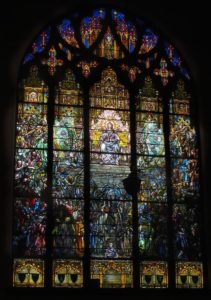
Serendipity, according to Merriam-Webster, is “the faculty or phenomenon of finding valuable or agreeable things not sought for,” and what better description could there be for the wealth of work by one of America’s most acclaimed artists, Louis Comfort Tiffany, located – but often overlooked – in our towns? Tiffany’s glorious stained glass, mosaics, and design features – perennial favorites at the Metropolitan Museum in New York – can be visited in churches and other local spaces, from Irvington through Tarrytown and Briarcliff to Ossining. Who knew?
Tiffany – the son of famous jeweler Charles Tiffany – reached the peak of his career in the late nineteenth and early twentieth century, when the arts and crafts movement, and the appetite for colored glass windows and objects were at their height. First drawn to art, but later finding his métier in the world of glass, Tiffany beat out competitors to achieve international fame and success. His workshops contained some 5000 samples of colors and varieties in glass. No shade or texture was beyond him.
He experimented obsessively, hiring glassblowers and chemists from around the world, while developing unique innovations, like the twisting of molten glass to achieve the remarkable folds of drapery to be found in many of his windows. This and other characteristic techniques, like confetti glass – adding specks of color to give an effect of looking through foliage – can be seen to gorgeous effect in the windows in our area.
Tiffany had a long association with Irvington, spending childhood summers there, in one of the “two substantial houses overlooking the Hudson, about the equivalent of two blocks north of Main Street… in the Matthiessen Park neighborhood,” said Christopher Mitchell, past co-chair of the Tiffany Room Committee. “That latter neighborhood, or at least part of it, was known as ‘Tiffany Park’ when the Tiffanys lived there.”
Unsurprisingly, multiple examples of Tiffany’s work are visible in the town, from the beautifully restored Reading Room at the Village Hall which he designed, decorated and furnished, to the 185 windows he installed at Irvington Presbyterian Church, all in a beautiful, pale, rainbow-hued, opalescent glass that lends a meditative tranquility to the interior space.
Next door, at the Church of St Barnabas, you can find a deep-set circular window in a glowing shade of blue, featuring a dove descending against a lemon sky. “It’s a hidden gem, which we’re delighted to share with anyone who wants to come and experience God’s radiant light,” commented current church rector, the Reverend Gareth Evans.
If Tiffany’s life’s work was “the pursuit of beauty” – as he told guests at his 68th birthday, in 1916 – he achieved it most memorably in his landscape windows, showcases for supreme technique through depictions of trees, rivers, and flowers, in particular irises, peonies, magnolia, and wisteria. The window at Tarrytown’s Reformed Church is one such, a glowing vista composed by Agnes Northrop, one of Tiffany’s most noted designers, featuring a stream descending a mountain valley, through banks lined with poplars and irises. It rests in a specially-built antechamber, positioned to receive the afternoon light which illumines its subtleties and sets the water rippling.
Briarcliff’s Congregational Church is blessed with seven Tiffany windows, the largest of them another, spectacular landscape, this one wooded, with rolling hills, an intricate sky, and a wide bank of irises. Its loveliness makes an interesting contrast with a smaller window toward the rear of the church, where St George battles a dazzling green dragon spewing red and yellow flames. Visiting children find this one “cool.”

Mother Cooper, the priest in charge at Ossining’s Trinity Episcopal Church, notes that having Tiffany windows “makes a difference in the feeling of the space,” and it’s true. Their beauty and unique style are surely both distractions and enhancements in a house of worship. “Attendees have their favorites,” she said. Mine, in that church, would be “The Salutation,” in which the two women, Mary and Elizabeth, embrace each other against a wide sky. Its intimacy compares strikingly with the huge, triumphant window at the nearby Ossining United Methodist Church, entitled Christ Enthroned, and packed with detail and Tiffany effects.
At Lyndhurst, the historic Gothic mansion in Tarrytown, there is Tiffany work aplenty, including multiple windows. “What’s relatively little known is that Helen Gould, Lyndhurst’s fourth owner and daughter of railroad baron Jay Gould, was a major patron of Tiffany’s, purchasing his best stained glass window, best glass vase, largest enameled vase and bringing him in and paying the bills for the Irvington Library and the NYU Library,” said Howard Zar, Executive Director of Lyndhurst. “The Goulds knew Louis Comfort Tiffany from the Presbyterian Church in Irvington, which they both attended.”
The largest Tiffany window at Lyndhurst, entitled “Angel of the Arts,” uses colored glass for its figurative and floral elements, but includes three clear panes giving framed views over the park. Elsewhere, the house displays some of the objects that Tiffany went on to make as he diversified – candy dishes, desk sets, a glass light-diffuser in the shape of a moth, and a striking “linen fold” table lamp, its white glass panels crimped and pleated to resemble fabric.
As history and fashion rolled forward, Tiffany’s work fell out of fashion and many of his windows, lamps and more have been lost to fire, demolition, neglect, and decay. All the more reason, especially in this season of thanks, for us fortunate Lower Hudson Valley dwellers to take a moment and relish the glories on our doorstep.
The Tiffany Trail website – www.tiffanytrail.com – developed by Irvington Village was of invaluable help in the writing of this article. It has details of how to find and access all the places mentioned above and several others, stretching from Irvington to the Bronx.







Gratitude for this guide to the wonders to be found in our own “backyard.”